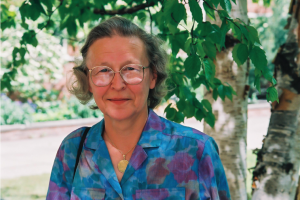Obituary for May 2022
Submitted by Sorana Froda, Université du Québec à Montréal, and Jim Zidek, University of British Columbia
On September 21, 2021, mathematical statistics lost an emblematic figure: Constance van Eeden, an ASA (and IMS) Fellow since 1972. Constance made an enormous contribution to statistical science as an educator and researcher through an active career that spanned more than half a century.
 Beginnings. Constance was born in Delft, The Netherlands, on April 6, 1927. Her family spent the trying war years in Bergen op Zoom.
Beginnings. Constance was born in Delft, The Netherlands, on April 6, 1927. Her family spent the trying war years in Bergen op Zoom.
Constance earned her BS in 1949 from the University of Amsterdam and worked on her MS and PhD while employed by the Mathematical Center (now CWI) in Amsterdam. She earned her PhD cum laude in 1958 as one of the four PhD students of renowned mathematician David van Dantzig on a topic that stemmed from consulting work supervised by Jan Hemelrijk.
In 1960, Hermann Rubin invited Constance to Michigan State University, where she met her husband, the gifted statistician Charles Kraft. After a short stay at the University of Minnesota, Constance and Charles were invited to join the Université de Montréal faculty. Their arrival gave a big impetus to statistical science in Québec. Sadly, Charles passed away in 1985.
The educator. Constance was a great educator and an exemplary and quite unique adviser and mentor to 14 PhD and 19 MS students. She instilled in her students her professionalism and need for rigor in their research. During her 75th birthday fest in May 2002, numerous students referred to the generosity and patience of “Madame van Eeden.”
The researcher. Constance’s research career spanned more than 50 years. During that period, she published two books and more than 70 peer-reviewed papers, many of which were written with her principal collaborators, Charles and Jim Zidek. Her credo as a researcher was expressed in her 2010 interview in Liaison: “I don’t think statistics could survive if we did not have the input of actual problems.” Yet she was a passionate scholar, imaginative, curious, and in love with research for its own sake. For her, mathematics, like art, possessed an inner beauty, without regard to how it might be applied. Even writing it up for publication was for her a creative endeavor.
Constance’s earliest research, in the 1950s, reveals her intellectual depth, mathematical skill, and originality. Always well ahead of her time, she in her PhD thesis proposed and initiated the development of a new subarea of statistical science, namely inference for restricted parameter spaces. (Dan Brunk proposed the subarea independently at about the same time.) She recognized the importance of that restriction; procedures, which built on it, could outperform those that did not. That work culminated in 2006 with her publication of a Springer monograph on estimation in restricted-parameter space.
In another direction, Constance pioneered the development of nonparametric statistical inference in work cited in Hájek-Šidák’s classic book on rank tests. Jointly with Charles, she published in that field other seminal papers in major journals such as the Annals of (Mathematical) Statistics and JASA; their innovative book on that topic appeared in 1968. On the strength of those contributions, Kraft and van Eeden became household names in the discipline. Moreover, as many of her students worked in nonparametric statistics, she is the founder of the Québec school of nonparametrics.
As for her contributions in other fields, we would mention her collaboration with Zidek throughout nearly three decades that stemmed initially from his work on group Bayesian theory. But, in a natural way, it evolved through other domains such as restricted parameter spaces, weighted likelihood estimation, combining sample information, and the characterization of stochastic uncertainty. Finally, in a new direction, it led to Bayesian subset selection.
All her collaborators appreciated her extremely high standards, keen sense of precision and originality, and love of the discipline. Most and foremost, she would never rush into publishing; drafts of her papers had to sit in a drawer for a while. Her passion for research was infectious. She inspired generations of students and research partners—perhaps the greatest of all her contributions to the creation of knowledge in statistical science.
Editorial work. Constance’s sharpness as a reviewer was proverbial. That sharpness combined with her lofty standards led to associate editorships in the Annals of Statistics (1974–1977), Canadian Journal of Statistics (1980–1994), and Annales des Sciences Mathématiques du Québec (1986–1998). Perhaps her most significant editorial contributions stemmed from her editorship of the International Statistical Institute’s abstracting journal (1994–2004), rewarded in 1999 with the Henri Willem Methorst Medal.
Retirement and honors. Constance chose to retire in 1988 and became Professeur Émérite at Université de Montréal. Besides, 1989 marked the beginning of her long-term multifaceted involvement with the University of British Columbia as honorary professor of statistics for more than 20 years.
Her extraordinary career was rewarded by numerous honors, the most salient being a Statistical Society of Canada Gold Medal (1990). In 2003, the Institute of Mathematical Statistics published a Festschrift volume in her honor. At the time of her passing, she was an honorary member of both the Canadian and Dutch statistical societies and an elected member of the ISI. The Université de Montréal established, in 1998, the Prix Constance van Eeden to be awarded to the best BS graduate in statistics.
The person. Constance always praised her students; her daughter, Kari; and her stepchildren. She viewed herself as a problemsolver; her favorite pastimes were crossword puzzles and knitting. Her personality is epitomized by the village of her retirement, Broek in Waterland, where lives move at a slower pace. The surrounding green pastures must have contributed much to her passion for life and her immense store of creative energy.
Both Constance the person and Constance the icon will be missed.

















